The dream of every fisherman is to fish in a wild stream — to be the first person in years to cast at completely wild fish. In a world of nearly eight billion people, such places are very difficult to find.
Until this past August, I had done this only three times. The first time was on a tributary of the Upper Rio Puelo in Chile, about 200 miles upstream from Puerto Montt. This was a wild stream fed by glacier runoff. My guide and host, Kent Schoenauer, said he had seen some trout in the stream when he crossed it on horseback. We had to hike a couple of miles and then wade in. With nearly every cast into a pool or a ripple, a trout rose to take a fly.
The second time was with grayling in an unnamed stream that feeds one of the many unnamed lakes in Canada’s Northwest Territories.
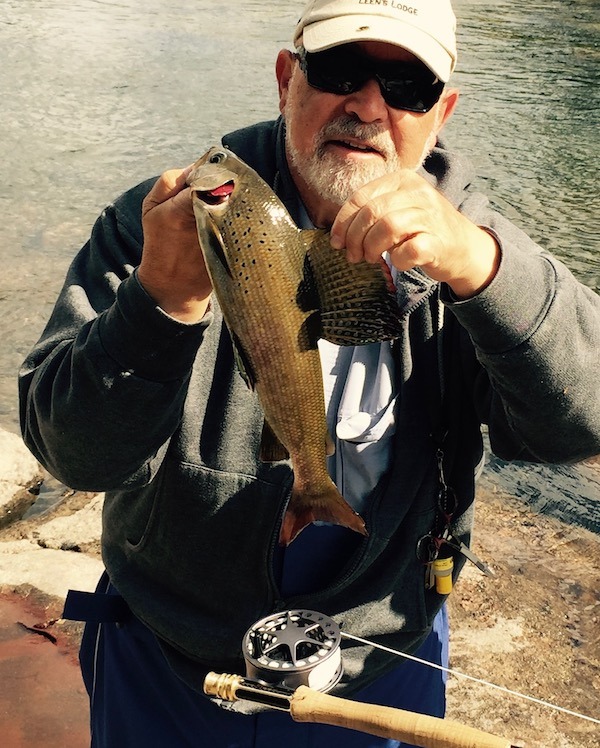
The third time was on a tributary of the Zambezi River in Zambia. That’s a story in itself.
We left Lusaka airport with a young bush pilot, fishing gear bag, suitcases, and four people. The single-prop, six-seater Cessna flew an hour over mostly jungle. Landing on a dirt airstrip, we found ourselves standing in a scene from a Hemingway novel. No buildings or people. Just the strip, a wind sock, and a clearing with an elephant herd grazing nearby.
“They will come for you,” the pilot said. He unloaded our stuff, climbed back into the plane, and took off. I worried about becoming a meal for lions that night. Finally, after a very long 40 minutes, a jeep appeared.
We rode, bouncing, for two hours, twice fording streams, to a tent camp on the Zambezi River. The next day we spent in a 16-ft. boat on the Zambezi as our guide dodged hippos while crocs eyed us from the shore. Some of those crocs were big. All this for a single day fishing in a wild water Zambezi side channel, where the fast-moving current discouraged the hippos from gathering. The tiger fish below made the effort worthwhile.
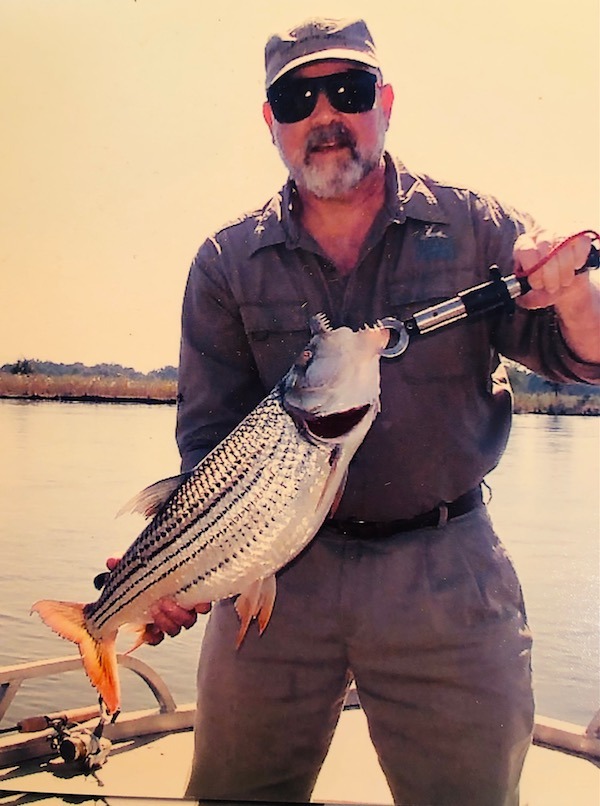
Never did I think I would find another wild stream, let alone find it in between the two weeks we gathered for our August 2021 confab at Leen’s Lodge. As the expression goes, “You can’t make this stuff up.”
The story starts on the deck in front of Leen’s Lodge on Monday morning. The week one group was gone; the week two group was due on Wednesday. I had a break. There was no one else around, just me and Ray Socabasin, my fishing guide and friend of 25 years. We planned to fish that day on a remote, special little lake called Wabassus, which is too restricted for a group. But first I had to check in with the office and get a handle on the markets.
The Lodge’s Wi-Fi worked, and I got into my office system, but the telephone signal was too weak to get me the verification code I needed in time. I got timed out repeatedly.
I conferred with Ray. “Ray, I need to get in before we go fishing,” I said. So we went to the village, where I hoped for a stronger signal. No success. Now what? “Let’s go to the Musquash Bridge,” I said.
The bridge across Big Musquash Stream lies halfway between Princeton, Maine, and the village of Grand Lake Stream. It is also near a cell tower, so there is a spot on one end of the bridge where the signal from the tower gives you three bars on your cell phone. Walk a hundred feet in either direction, and the signal weakens. I stood on the hot spot, got in, verified, and down came a load of messages.
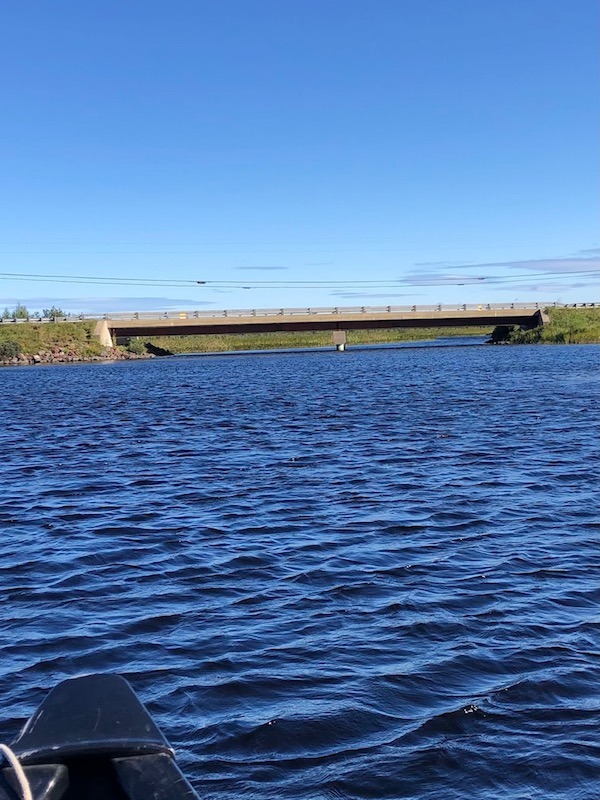
“Ray,” I called out, “I need a half hour’s work time before we can shove off. Let’s skip the Wabassus trip and put the canoe in here.” Ray is very patient. Here he is holding a very large pickerel taken in Big Lake, which is the body of water that receives the outflow of Big Musquash Stream.
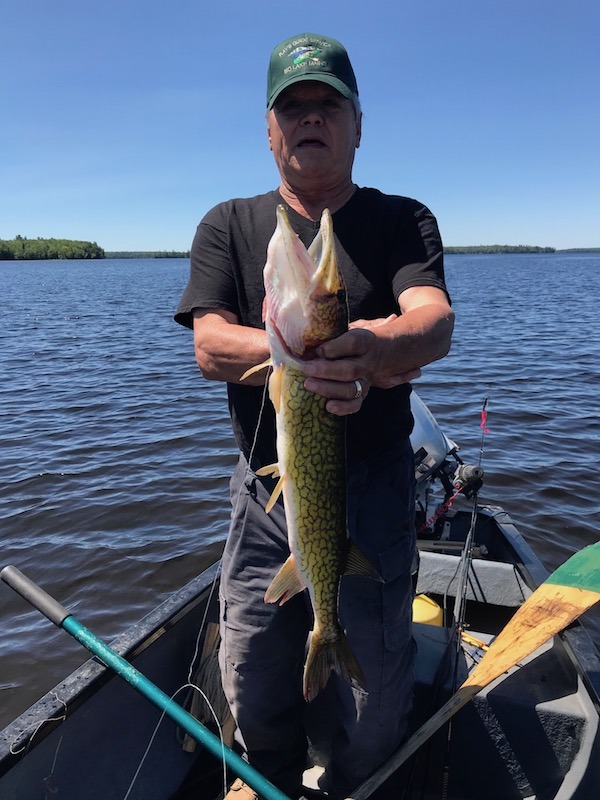
A half hour later, we were heading upstream on the West Branch of Big Musquash Stream. The stream was wide here and flowed though grassy meadows. Distant on either side, forests skirted the meadows, and a small mountain rose against the sky a few miles away. We saw deer, eagles, moose crossings, and beaver dams — all pristine and wild and all on the Passamaquoddy Indian Reservation land.
We rounded a bend, and there a smaller tributary flowed into the big stream. In thirty-four years of visiting this region, I had never been up there. It was the East Branch of Big Musquash Stream!
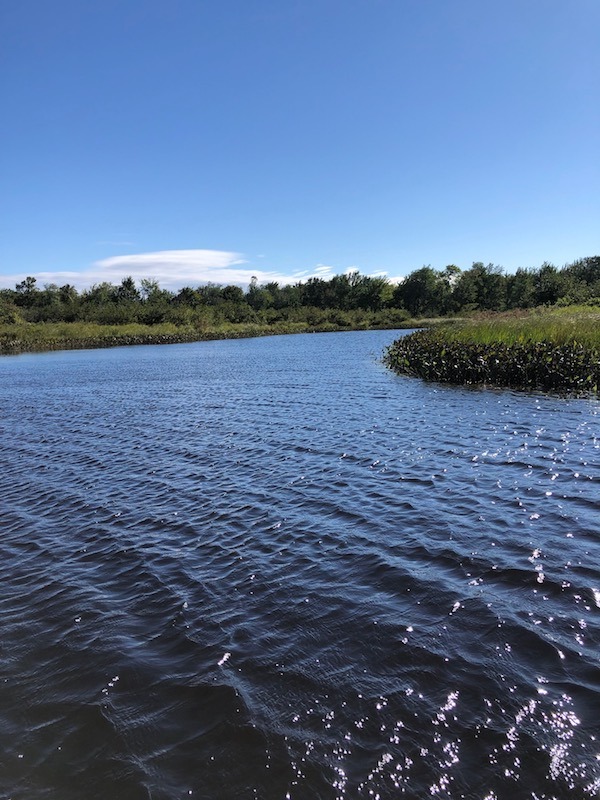
“Hey, Ray, what’s up there?” I called loudly enough for my voice to carry over the boat motor and wind noise.
“That’s where my brother’s cabin is.”
Hmmm. “Who goes there now?” I asked.
Ray was pensive. “Nobody goes up here since he died.”
I mulled his response. “How about us taking a look?”
Ray is a man of few words. This is a place of his history and his tribal land. I knew his older brother Dave for years and had fished with him. Dave Socabasin was the elder, the mentor, the confidant. On tribal land he knew every tree and rock. We were about to visit a part of that heritage.
Ray nodded his head slightly. Silently, he turned the canoe into the East Branch.
After a few turns, the stream meandered beyond the grassy meadow into higher land with trees and woods. Rocks and fallen trees, moss-covered overhanging limbs, and enticing, dark-shadowed fishing pools greeted us. Beneath the stream’s mirrored surface, underwater grasses swept gently in the direction of the current, weaving back and forth in the moving water, but no ripples broke the surface.
There were no signs of visitors. No beer cans or other trash or anything else. Here was a place untouched by hands, unmarred, as it had been for years. Trying to capture something of the magic of this pristine place, I snapped photos with my iPhone as we traveled up the East Branch in the direction of Dave’s cabin.
After about 20 minutes, as one beautiful scene ceded to another, we rounded a turn and entered a long pool.
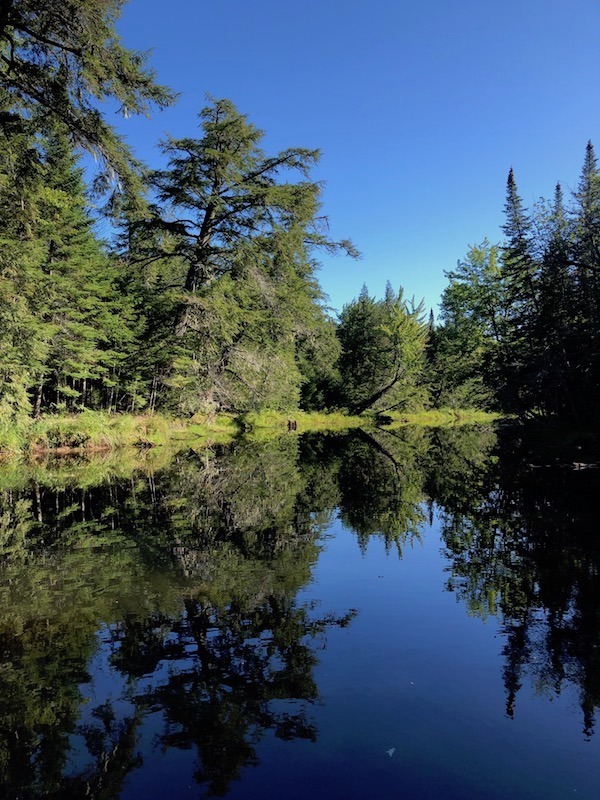
“It’s up there,” said Ray. While I had been busy with photography, Ray had been mentally replaying some of his history with his brother. Later, he related stories of hunting and fishing, trapping beaver, and taking sportsmen up on moose hunts. After Dave’s death, Ray stopped coming to this place. Now, a few years later, he was confronting the loss of his brother again, but he was also establishing a new way to handle the memories.
We could barely make out the cabin. The clearing in the woods that surrounded it was now overgrown with brush. Clearly, the place hadn’t been used in several years. The forest was encroaching on all the work Dave had done in the past.
We headed to the shore. Ray remembered a spot where the nose of the canoe could fit, and in we went. Ray pushed the canoe up to the bank, and I got out without falling into the stream and tied up the boat. Then we climbed through the weeds and brush. The cabin was unkempt and choked with dust. No maintenance had been done for years. The outdoor latrine had rotted, as had a shed. It was a sorry-looking site and sight.
“What do you want to do?” I asked.
Fast-forward about two hours, and we had started to map out a clean-up plan. Ray reached a nephew and a niece, they reached two others, and a next-day work party equipped with a chainsaw and rakes was organized. The plan was to clean up the cabin, replace rotted wood, rebuild a fire pit for cooking, and clean up the shoreline for a canoe to tie up. There would be trash to haul away and a dozen other tasks.
When we had all the arrangements made, Ray and I climbed back into his canoe and ate our sandwiches in silence. We motored back to Musquash Bridge, pulled his canoe out onto the trailer, and drove back to Leen’s Lodge.
“How about we fish the that stream tomorrow while all the clean-up work is being done,” I suggested.
“Okay,” he said.
On Tuesday, we again put the canoe in at Musquash Bridge and motored up the East Branch past the cabin as far as we could go. Trees had blown down across the stream, and we didn’t have a chainsaw to clear them. Ray described what was ahead, and we agreed that was for a future trip. He turned the canoe around, and we started to drift with the current. I fished from the front. Ray guided and paddled from the rear.
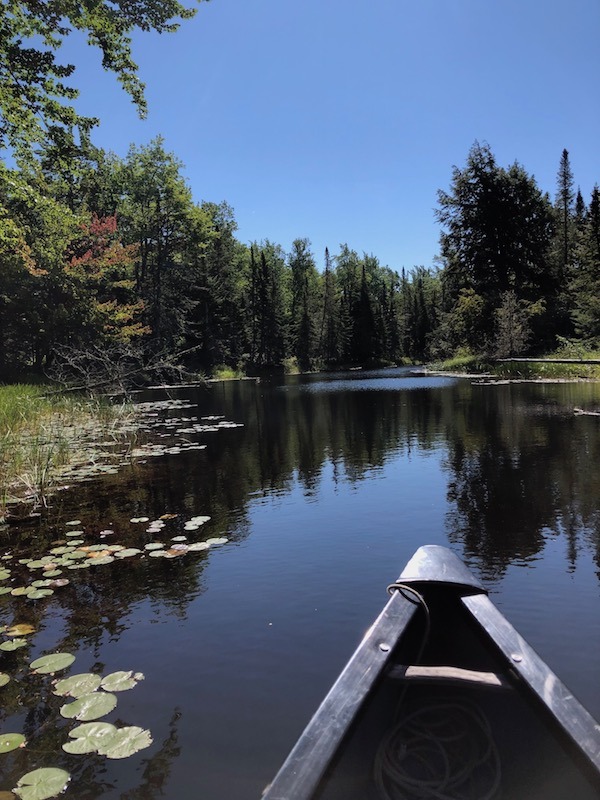
Nearly every cast raised a fish. Smallmouth bass and some pickerel. As the stream got deeper, the fish became larger. They would hit almost any type of spinning-rod lure. I changed lures about every ten casts to see just how these fish were reacting. On the fly rod, most surface-type poppers or dragonfly imitations worked well. I was fishing in a wild stream.
We fished for about two hours before we reached the cabin site. There, a hubbub of activity was well underway. The brush had been cleared. The cabin was being cleaned up. Firepit rebuilding had started. Four busy people were restoring Dave Socabasin’s cabin site to its former hospitable state.
“Will we be able to use it tomorrow?” I asked with some hesitancy.
“Yes” was the confirming reply.
After the cabin stop, Ray and I had our Tuesday lunch in the canoe. Then we fished the lower stretch from the cabin to where the East Branch empties into the West Branch and becomes the full Musquash Stream. I caught fish continually. They fought hard, and they grew still larger as the stream grew wider and deeper.
Here's a photo of a smallmouth bass caught on a fly rod with a popper. This was a typical fish.
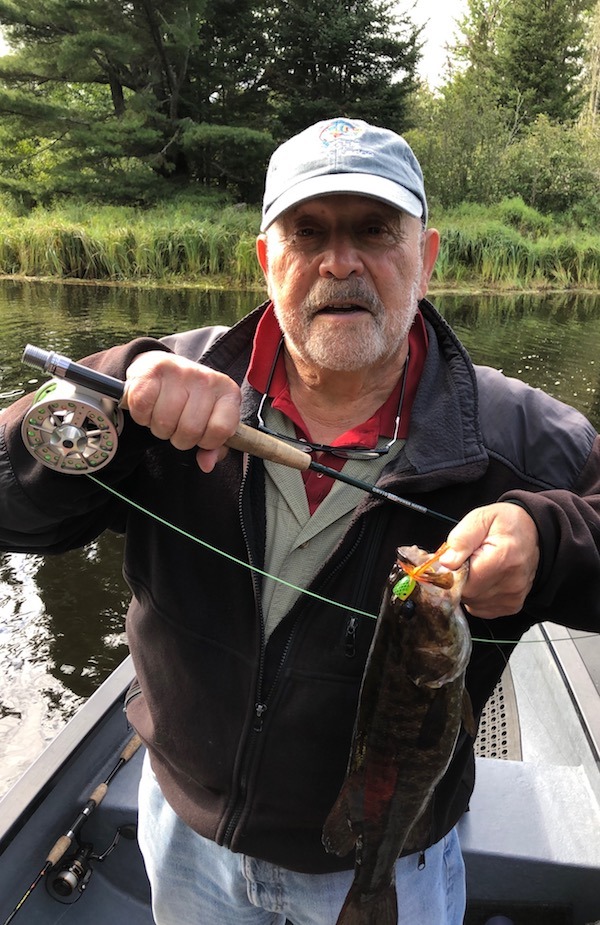
On Wednesday, we were three canoes. Six sports fishermen and -women and three guides cooked freshly caught fish for lunch at the new firepit. Wednesday was a milestone day. Here’s a Wednesday look at the cabin and the site.
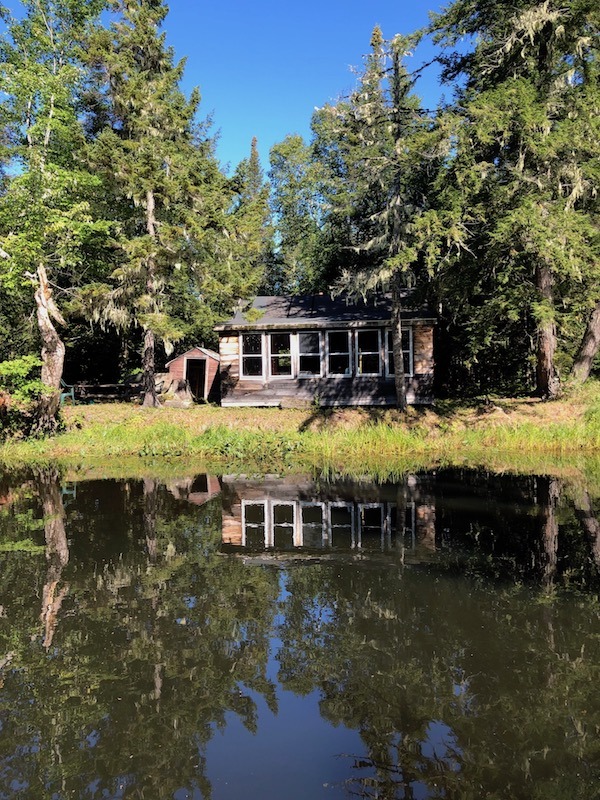
Wild streams come in all shapes and sizes. Each one is a story. This time we restored history, shared memories with friends, and rebuilt a cabin. All because I got timed out on a Monday morning. Who’da thunk it?
Chairman of the Board & Chief Investment Officer
Email | Bio
Links to other websites or electronic media controlled or offered by Third-Parties (non-affiliates of Cumberland Advisors) are provided only as a reference and courtesy to our users. Cumberland Advisors has no control over such websites, does not recommend or endorse any opinions, ideas, products, information, or content of such sites, and makes no warranties as to the accuracy, completeness, reliability or suitability of their content. Cumberland Advisors hereby disclaims liability for any information, materials, products or services posted or offered at any of the Third-Party websites. The Third-Party may have a privacy and/or security policy different from that of Cumberland Advisors. Therefore, please refer to the specific privacy and security policies of the Third-Party when accessing their websites.
Cumberland Advisors Market Commentaries offer insights and analysis on upcoming, important economic issues that potentially impact global financial markets. Our team shares their thinking on global economic developments, market news and other factors that often influence investment opportunities and strategies.






